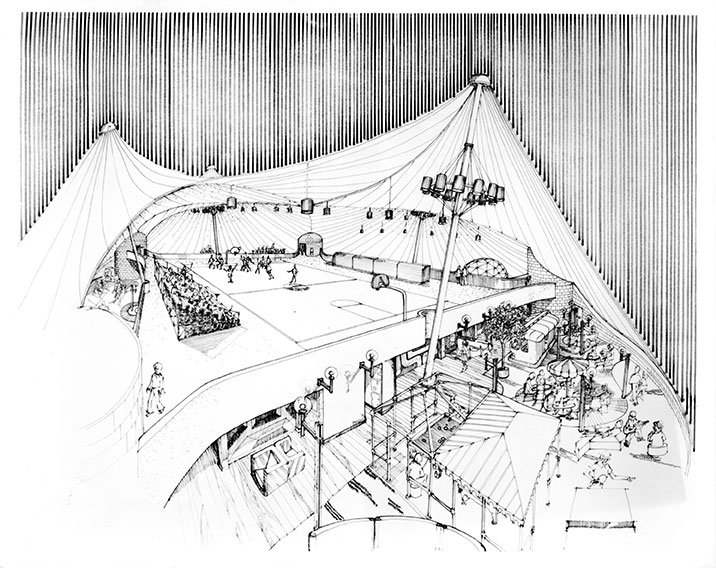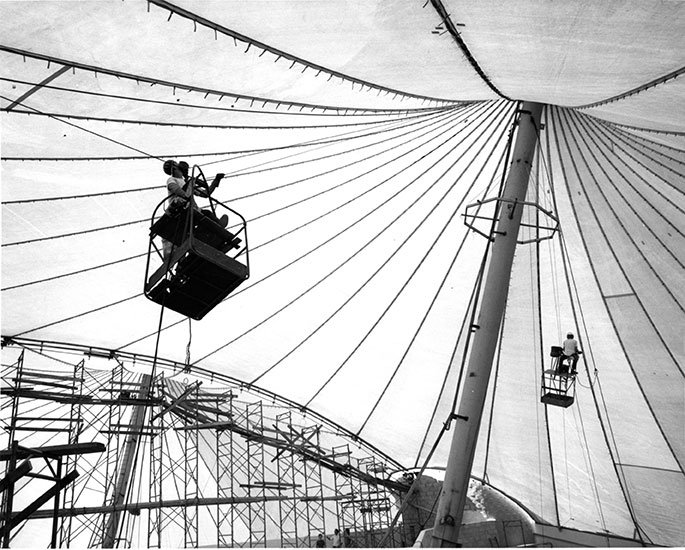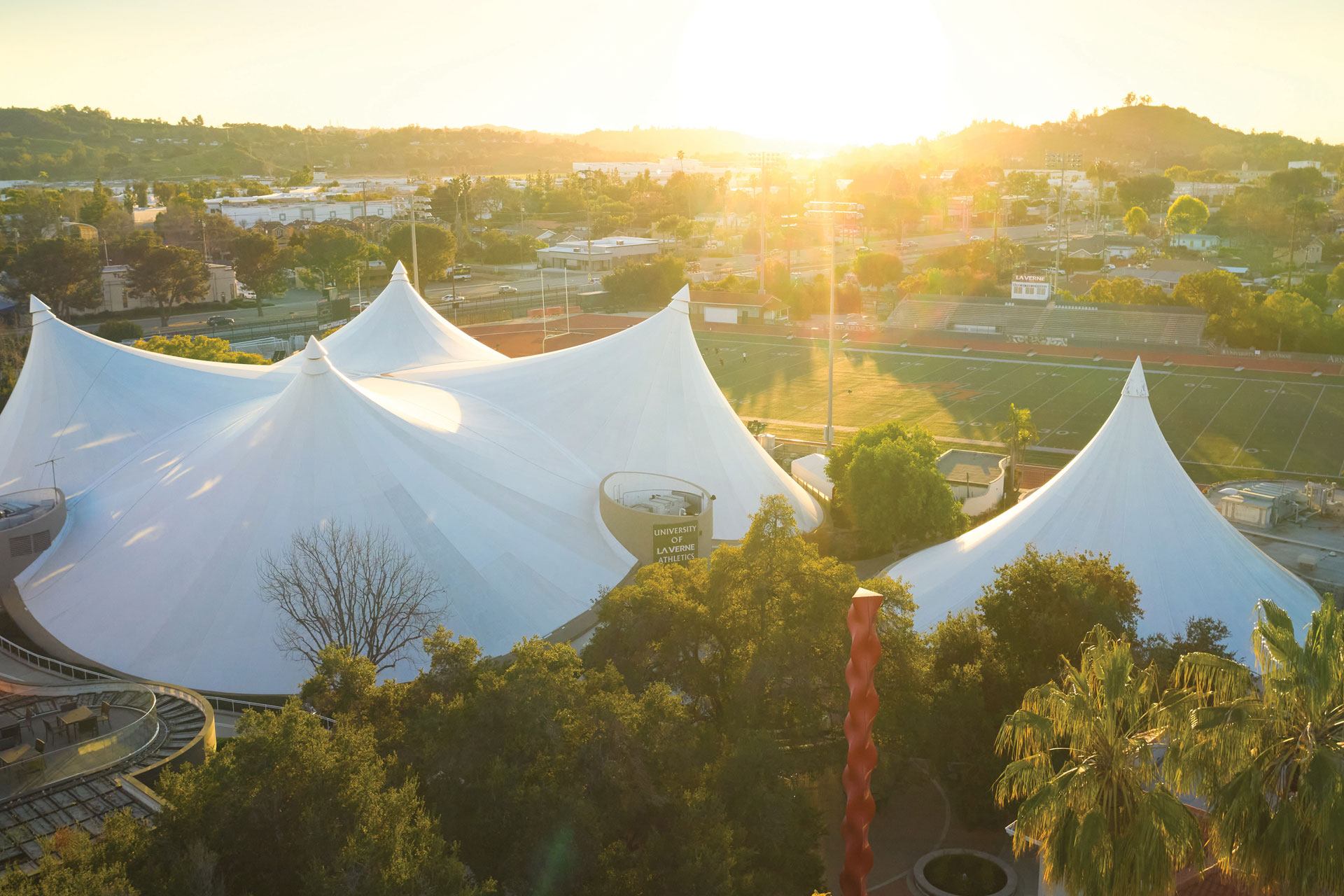Super Tents Celebrate 50-Year Anniversary
In 2023, 50 years after completion, the Super Tents continue to meet the needs of what is now the University of La Verne.
April 21, 2023
In 1968, then-La Verne College President Leland B. Newcomer ’42 was tasked to create new facilities and solutions for the university’s rapidly growing footprint.
Newcomer recalled five years later that he was “literally barraged with requests from faculty, students, and darned near everybody for new buildings. We needed a new gym. We needed a new theater and creative arts building. An accreditation committee that visited us said our number one need was for a student union.” (San Bernardino Sun, May 16, 1974)
The old gymnasium, built around 1920, was leaky and the university needed a replacement space for physical education. The campus also lacked a gathering place, a theater, and needed additional classrooms and office space. Campus leaders estimated it would cost $7 million to $10 million to meet the campus’ need for increased space.
 To help fund the project, Newcomer secured a grant from the Ford Foundation’s Educational Facilities Laboratory. Campus officials, members of the faculty, and professional architects spent two years designing a structure to fit the needs and budget of the college.
To help fund the project, Newcomer secured a grant from the Ford Foundation’s Educational Facilities Laboratory. Campus officials, members of the faculty, and professional architects spent two years designing a structure to fit the needs and budget of the college.
Traditional architectural solutions proved financially restrictive. As a result, the Board of Trustees voted in 1970 to create a pair of buildings using experimental design. The project team proposed a new type of construction with a fiberglass exterior coated in Teflon. The two structures would ultimately take the shape of a set of tents with pointed peaks jutting into the sky. In addition to housing the student center and theater, the plans included a snack bar, pool tables, and classrooms; ultimately striking a balance between educational and leisure space.
When completed, the Student Center and Dailey Theatre would comprise a total of 68,383 square feet spread across 1.4 acres. The college spent $3 million to complete the structures, a much lower price tag than a conventional building would have carried. In addition to saving millions of dollars for La Verne College, this strategy guaranteed the institution would become an architectural pioneer with an iconic campus landmark.
La Verne College celebrated the completion of the Super Tents in 1973. College leaders stressed that, despite the superficial resemblance to tents, the buildings were permanent, not temporary, with Teflon protecting them from fire and inclement weather.
Around 1980, the multipurpose building added more programs and services including a radio station, a darkroom, offices for the student-led newspaper the Campus Times, social space, and a basketball court and portable bleachers that could house 800 spectators. Locker rooms, classrooms, and offices completed the building.
 La Verne College’s Super Tents became a local and regional architectural phenomenon—and a curiosity. Professor of History Nicholas Polos, in an article about the Student Center and Dailey Theatre, playfully referred to the buildings as “Circus-Circus” or “The Udder Thing.”
La Verne College’s Super Tents became a local and regional architectural phenomenon—and a curiosity. Professor of History Nicholas Polos, in an article about the Student Center and Dailey Theatre, playfully referred to the buildings as “Circus-Circus” or “The Udder Thing.”
The innovative buildings attracted significant, sustained press coverage. DuPont Corporation, the company that developed Teflon, aired a commercial about the Super Tents. KABC, U.S. News & World Report, The Chronicle of Higher Education, and Los Angeles Times all reported on the Super Tents. Architectural journals regularly covered the buildings. Per Fabrics & Architecture, the buildings became the “first permanent, enclosed membrane structures in the United States to use PTFE-coated fiberglass fabric.” Other buildings followed the model offered by La Verne College and adopted fabric structures.
In 2023, 50 years after completion, the Super Tents continue to meet the needs of what is now the University of La Verne. A weight training center and the offices of the kinesiology department maintain the building’s link to physical education. A basketball court on the second floor doubles as event space. The Hall of Fame and an installation about the history of athletics at the university solidify the building’s link to its history. Finally, the Dailey Theatre continues to showcase the talents of the theater department. In short, the Super Tents remain a vibrant element of campus culture.
